Lire le communiqué de presse de l’Université de Strasbourg
Contact scientifique :
Benjamin Bacq-Labreuil
benjamin.bacq-labreuil@ipcms.unistra.fr
Contact scientifique :
Benjamin Bacq-Labreuil
benjamin.bacq-labreuil@ipcms.unistra.fr
Alors que la miniaturisation de l’électronique traditionnelle à base de silicium approche de ses limites physiques, l’industrie des semi-conducteurs fait face à des défis croissants : inefficacité énergétique, goulots d’étranglement dans les architectures de type von Neumann, et une rigidité du matériel inadaptée aux besoins de l’intelligence artificielle. Les nouvelles applications — telles que les systèmes autonomes, l’Internet des objets (IoT) et l’apprentissage en temps réel — exigent un changement radical dans l’intégration du calcul et de la mémoire à l’échelle nanométrique.
Développée par un consortium international de premier plan, comprenant l’Université de Strasbourg, l’Institut des Nanotechnologies de Lyon, l’Université Paris-Saclay et le National Institute for Materials Science (Japon), nous avons le plaisir de présenter une avancée majeure en nanoélectronique : le transistor à effet de champ à grille flottante inversée Van der Waals (IFGFET) — une nouvelle topologie de dispositif qui combine logique, mémoire et calcul neuromorphique dans une seule architecture.
Cette innovation repose sur des hétérostructures Van der Waals, combinant des semi-conducteurs ReS₂ avec une (top) grille flottantes polymorphique and une (bottom) grille de control. Cette topologie permet l’accès direct à la grille flottante et améliore considérablement le contrôle électrostatique du canal.
En outre, cette technologie offre des caractéristiques révolutionnaires telles que :
Ce dispositif reconfigurable pourrait ouvrir la voie à de nouveaux horizons en calcul en mémoire, calcul neuromorphique, réseau à spike et matériel IA sécurisé.
👉 Retrouvez l’article complet dans ACS Nano: Lien vers l’article
Contact : dayen@unistra.fr
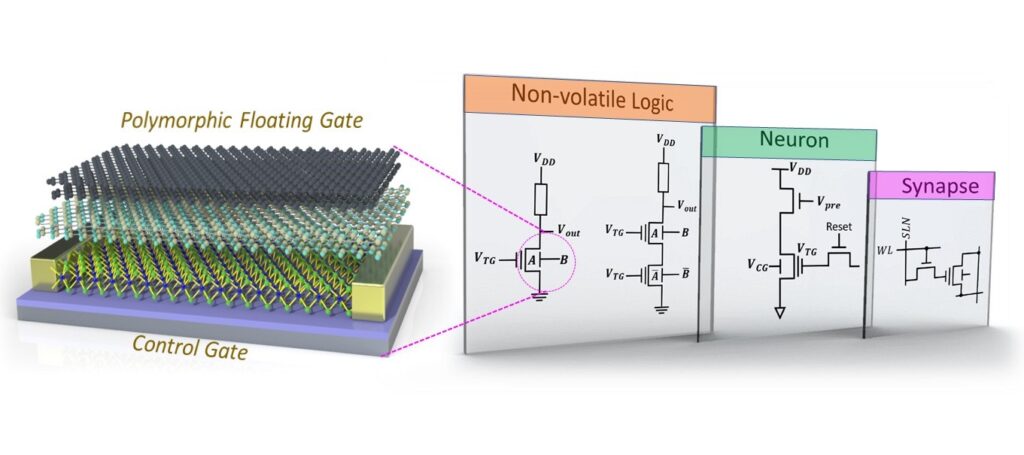
Référence
Semiconducting Overoxidized Polypyrrole Nano-Particles for Photocatalytic Water Splitting
Xiaojiao Yuan, Girlie Eunice Lopez, Viet-Dung Duong, Samy Remita, Diana Dragoe, Dris Ihiawakrim, Ovidiu Ersen, Yannick Dappe, Winfried Leibl, Hynd Remita & Ally Aukauloo
Small 2025
https://doi.org/10.1002/smll.202407364
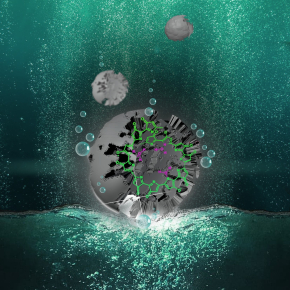
© Hynd Remita
Réference : Hoshang Sahib, Aravind Raji, Francesco Rosa, Giacomo Merzoni, Giacomo Ghiringhelli, Marco Salluzzo, Alexandre Gloter, Nathalie Viart, Daniele Preziosi
Superconductivity in PrNiO2 infinite-layer nickelates
Advanced Materials 2025
https://doi.org/10.1002/adma.202416187
Contact : Daniele Preziosi (Chercheur à l’Institut de physique et de chimie des matériaux de Strasbourg (CNRS/Université de Strasbourg) daniele.preziosi@ipcms.unistra.fr
Explications avec Paul-Antoine Hervieux, membre de la collaboration et enseignant-chercheur à l’Institut de physique et chimie des matériaux de Strasbourg (IPCMS – CNRS/Unistra).
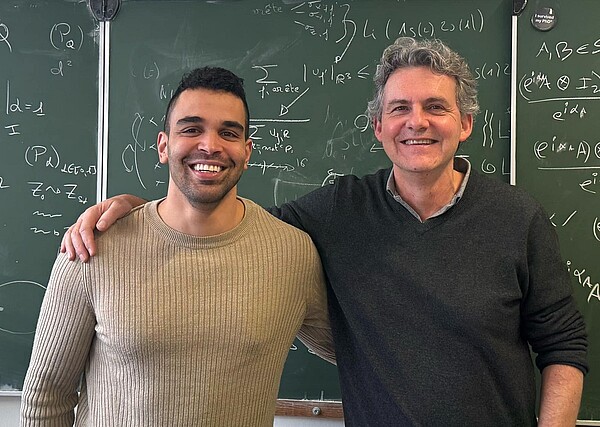
Paul-Antoine Hervieux et un de ses doctorants, Adrien Andoche, qui a soutenu sa thèse en décembre 2024. ©DR
“CORELMAG” fait partie des projets ANR 2019 : Nanocomposites innovants libérant des facteurs biologiques par hyperthermie magnétique en tant que composants de matrices intelligentes pour l’ingénierie tissulaire.
Coordinateur du projet : Damien MERTZ (IPCMS – DCMI)
Vous pouvez lire ou télécharger la BD sur cette page : https://www.alsace.cnrs.fr/fr/corelmag
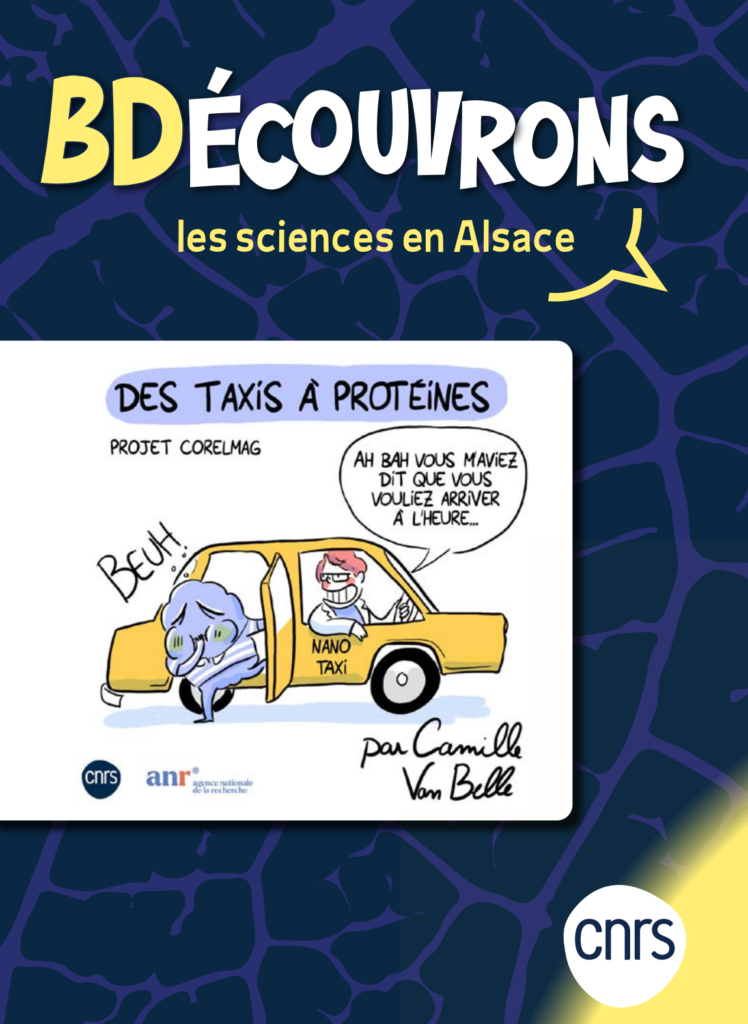
Initiative portée par le service communication Alsace du CNRS.
Programme d’accompagnement à la médiation scientifique : Sophie Le Ray
Planche de bande-dessinée réalisée par Camille Van Belle
Référence
Divergence of catalytic systems in the zinc-catalysed alkylation of benzaldehyde mediated by chiral proline-based ligands.
Thibault Thierry, Yannick Geiger & Stéphane Bellemin-Laponnaz
Nature Synthesis 2024
DOI https://doi.org/10.1038/s44160-024-00491-y
Contact : Stéphane Bellemin-Laponnaz
L’article paru récemment dans Nature Nanotechnology (Doi : 10.1038/s41565-024-01622-4) : Submolecular-scale control of phototautomerization / Anna Roslawska, Katharina Kaiser, Michelangelo Romeo, Eloïse Devaux, Fabrice Scheurer, Stéphane Berciaud, Tomas Neuman et Guillaume Schull, fait l’objet d’une actualité sur le site CNRS Physique.
https://www.inp.cnrs.fr/fr/cnrsinfo/vers-une-photochimie-lechelle-sub-moleculaire
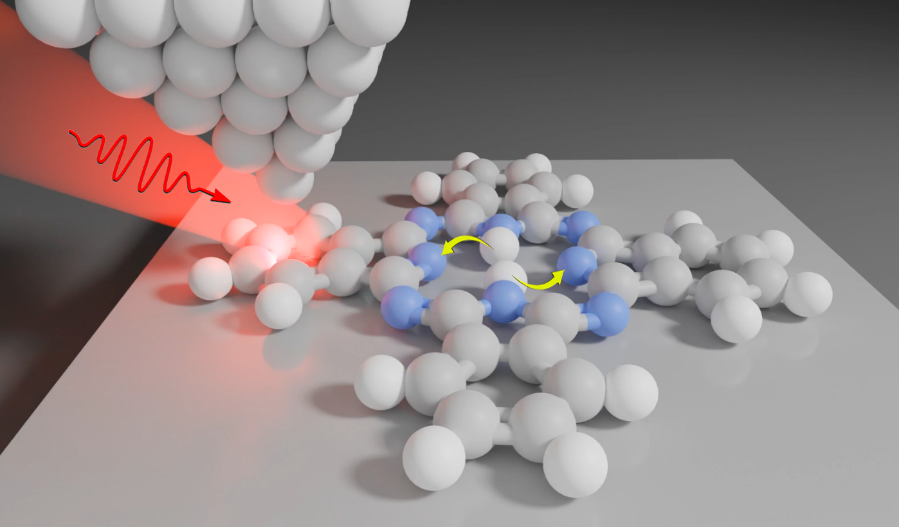
Figure : Contrôle local de la réaction de photo-tautomérisation de la phtalocyanine. La pointe métallique est visible dans la partie supérieure gauche de la figure © A. Rosławska et G. Schull.
Lire l’article complet sur le site CNRS – Nucléaire & particules
L’équipe DON-Dyno fait partie de cette collaboration (Gbar) depuis sa création.
Lien vers la publication associée à cet événement, qui vient d’être acceptée : http://arxiv.org/abs/2306.15801
An international consortium (University of Strasbourg, University of Luxembourg, NIMS Japan, Ecole Centrale Lyon, C2N Saclay) led by IPCMS (team of Jean-François Dayen, DMONS), established the concept for a new generation of reconfigurable ferroelectronic logic circuits.
These devices, referred as Re-FeFET, allow for encoding and manipulating the information in a single operating unit, circumventing the famous ”Memory Wall” limitation of modern CMOS technology. By making use of the switchable polarization state of two ferroelectric gates, the electrical potential landscape within a semiconductor channel can be permanently and reconfigurably modified. Depending on the ferroelectric state encoded, the ferroelectric logic circuits can function as six alternative logic gates, while CMOS circuit are limited to a single function. Last but not least, the device can operate as a photodiode and generate photovoltaic energy. These findings rethink circuit topology and memory-logic interaction, opening up new research directions in the area of frugal computational enhancement.
Reference :
Reconfigurable Multifunctional van der Waals Ferroelectric Devices and Logic Circuits
Ankita Ram, Krishna Maity, Cédric Marchand, Aymen Mahmoudi, Aseem Rajan Kshirsagar, Mohamed Soliman, Takashi Taniguchi, Kenji Watanabe, Bernard Doudin, Abdelkarim Ouerghi, Sven Reichardt, Ian O’Connor and Jean-Francois Dayen.
ACS Nano 2023, 10.1021/acsnano.3c07952. Link.

Contact : Jean-Francois Dayen
Reconfigurable Multifunctional van der Waals Ferroelectric Devices and Logic Circuits, Ankita Ram, Krishna Maity, Cédric Marchand, Aymen Mahmoudi, Aseem Rajan Kshirsagar, Mohamed Soliman, Takashi Taniguchi, Kenji Watanabe, Bernard Doudin, Abdelkarim Ouerghi, Sven Reichardt, Ian O’Connor et Jean-Francois Dayen, ACS Nano, publié le 21 octobre 2023.
Doi : 10.1021/acsnano.3c07952
Archives ouvertes : HAL